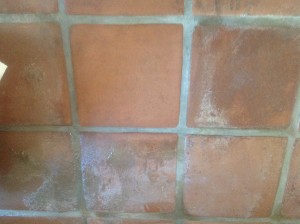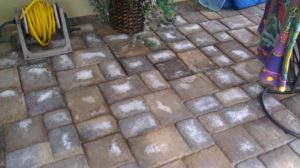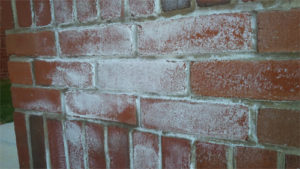
Why does my ARTO concrete tile have white powder on it ?
On June 30, 2017 by ARTOUnless you are partying at Charlie Sheen’s or Tony Montana’s house the white powder is almost certainly efflorescence.
It may sound serious but efflorescence is just a fancy word for salts that migrate to the surface. It is a normal phenomenon that can be seen in clay brick, concrete, mortar, grout, and in all types of masonry.
ARTO uses an efflorescence reducing admixture in our concrete mix so our products will have a minimal amount of salts. Water is necessary to transport these salts to the surface so efflorescence is almost never seen in interior applications (the only one I ever saw was from a broken water line to a refrigerator).
Efflorescence can sometimes occur outdoors but will usually exhaust itself as there is a finite amount of salts in mortar, grout, and concrete. However, nearby soils and planter beds contain large amounts of salts and can lead to recurring efflorescence. Flower pots and planter can also transport efflorescence in runoff water.
Water management including proper drainage and sprinkler placement can minimize efflorescence by limiting water that can transport salts to the surface.
How do you clean efflorescence?
1. NEVER USE ACID OR HARSH CHEMICALS as these can remove sealers and damage concrete surfaces.
2. In many cases efflorescence can simply be hosed off or brushed away when it is powdery.
3. Recurring or hardened efflorescence may require a specialized cleaner. We like Aldon Efflorescence Treatment as it is does not contain acids like many similar products.
How can you minimize the potential for efflorescence?
1. Use a high quality penetrating or breathable topical sealer for exterior installations. Most topical sealers will trap efflorescence and moisture under the sealed surface. Stripping the sealer (a messy and hazardous process that can damage the tiles) is the only way to remove the efflorescence.
2. Design and direct sprinklers to minimize water landing on the tiles. Remember, without water there is no way to transport the salts to the surface.
3. Keep flower pots and planters elevated and use drip irrigation systems to minimize runoff from these features.
4. Install a waterproofing membrane underneath the tiles in order to minimize water intrusion from the concrete slab and soil beneath. It is important to lap up the membrane at the perimeter in order to prevent water from entering from the sides.
Archives
- April 2023
- March 2023
- February 2023
- November 2022
- August 2022
- July 2022
- February 2022
- September 2021
- June 2018
- April 2018
- March 2018
- January 2018
- December 2017
- November 2017
- October 2017
- September 2017
- August 2017
- July 2017
- June 2017
- April 2017
- January 2017
- December 2016
- November 2016
- October 2016
- September 2016
- August 2016
- July 2016
- June 2016
- May 2016
- April 2016
- March 2016
- February 2016
- January 2016
- October 2015
- August 2015
- July 2015
- May 2015
- March 2015
- February 2015
- January 2015
- December 2014
- November 2014
- August 2014
- May 2014
- April 2014
- March 2014
- January 2014
- December 2013
- November 2013
- October 2013
- September 2013
- May 2013
- April 2013
- March 2013
- February 2013
- January 2013
- December 2012
- August 2012
- July 2012
- June 2012
- May 2012
- April 2012
- March 2012
- February 2012
- January 2012
- October 2011
- September 2011
- August 2011
Calendar
| M | T | W | T | F | S | S |
|---|---|---|---|---|---|---|
| 1 | 2 | 3 | 4 | 5 | 6 | 7 |
| 8 | 9 | 10 | 11 | 12 | 13 | 14 |
| 15 | 16 | 17 | 18 | 19 | 20 | 21 |
| 22 | 23 | 24 | 25 | 26 | 27 | 28 |
| 29 | 30 | 31 | ||||
Categories
- Adventures & Travel
- All Products
- Arabesque
- Architect
- Armen's Journal
- Artillo
- ARTO Manifesto
- Blog
- California Revival
- Careers
- Clay
- Commercial Pictures
- Community
- Concrete
- David Shipley
- Faces @ ARTO
- Hospitality Projects
- Impressions
- Industry News
- Monrovia
- New Stuff
- Oleson
- Project
- Residential Projects
- Review / Thank You
- Seth Godin
- Silk Road Tile Updates



Leave a Reply